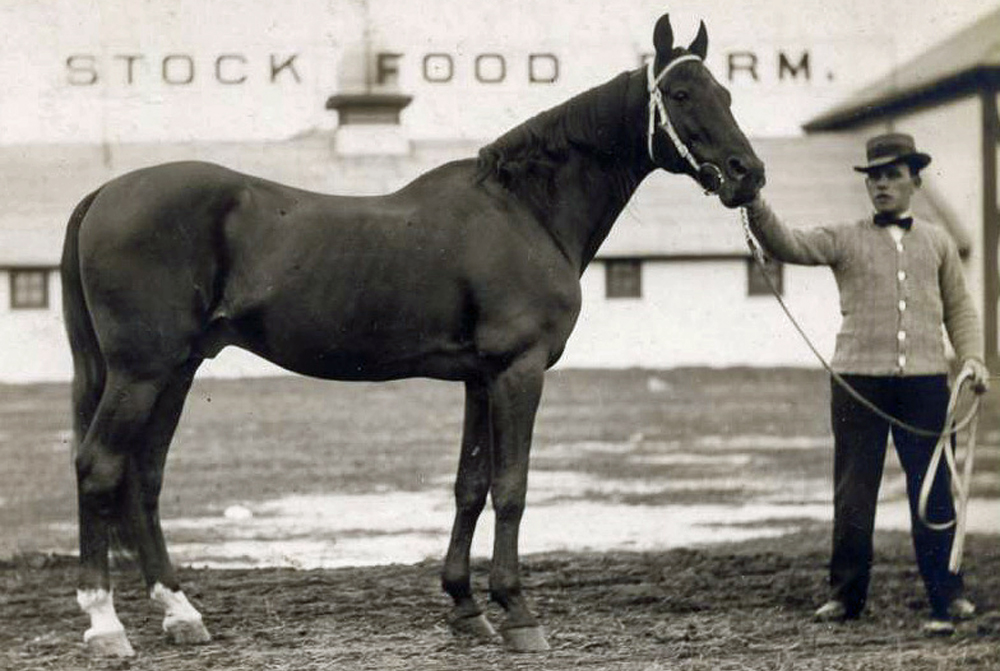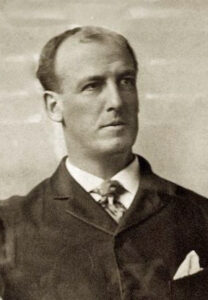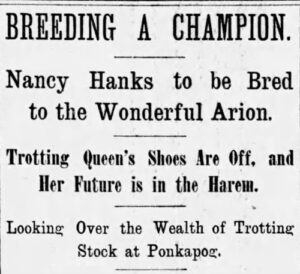True Tales from Canton’s Past: Stable of Champions
By George T. Comeau
Arion, pictured after he was sold from Canton at auction, held the fastest record for a 3-year-old colt.
When he was born under the watchful eye of Leland Stanford, he was named Arion, a reference to an immortal horse in Greek mythology that was very fast and bred by the gods. And so young Arion grew up to fit his name. Born in 1889 in Palo Alto, California, Arion was the new American royalty. And at the age of 3, the impressive colt made the trip east by train. The trip took a few days, and along the way he crossed the Continental Divide, the Great Plains, and eventually made his way to Boston. Transferring to South Station, he then embarked on a short trip to Readville, which marked the final leg of his long journey.
At Readville, Arion gingerly walked from the train. The morning sun glanced off his dark face and he breathed in the crisp January air. What a change from California for this young fellow. The walk to his final destination was not all that far, about three miles. Glancing across the snowy landscape, Arion adjusted quickly and stood up straight as he walked through the gates of his stately new home. At the foot of the Great Blue Hill in Canton, it was a major change in his life, but one that already was storied and fantastic.
Just a few weeks prior to Arion’s arrival, J. Malcolm Forbes sat in his office and contemplated the words of an associate who lived in the Berkshires. It was a secondhand conversation that Forbes had heard. Out in Pittsfield was an enormous farm that had been established in the 1880s by William Russell Allen, the great-grandson of Thomas Allen — the “Fighting Parson” — who was the first pastor of First Church and who contributed mightily as a soldier during the American Revolution. The farm was used for horse breeding and the venture was in full bloom by 1886.
Allen built a private race track on his farm, where he put his trotters through their paces. On that property was a barn that was said to be the biggest in the commonwealth. Made of Canadian spruce, it was 70 feet high, 100 feet wide and 210 feet long — just about the size of a football field, and just as impressive. The barn had 60 box-stalls, was steam-heated and partitioned with glass. Surrounding the barn were 30 other buildings that served as foaling sheds, blacksmith shops and the like. The conversation that Forbes had picked up on was between Allen and a close friend: “If I were as young as you and had gone through the expense of establishing a great breeding plant, there is one horse that I would own regardless of the cost.” That horse was Arion.
John Malcolm Forbes was born in Milton in 1847, attended Boston English and MIT, and was a wealthy investor born into money earned in the China trade of the early 19th century. The family was also heavily invested in railroads. The investment firm of J.M. Forbes & Company still exists in Boston today. Forbes was impressive and in his youth was a member of the Oneida Football Club — the first organized football club in the United States. Forbes, a distant cousin of Senator John Forbes Kerry, was an avid sportsman and skippered the yacht Puritan en route to winning the America’s Cup in 1885.
Forbes was a “quiet, scholarly looking man,” and did not fit the classic look of moneyed gentry. That said, he was fabulously wealthy and enjoyed many a gentleman’s sport, including horse breeding for harness racing.
The Forbes Stock Farm was the product of a lifetime of observing excellence and creating the best that could be built from limitless money. This farm would become the largest breeding establishment in America. Three separate properties — the Hunt, Davenport and Farrington farms — had been purchased to comprise 130 acres of the most famous breeding farm on the East Coast. The buildings were all painted a bright orange and were most impressive. And Forbes not only had an eye for champions; he also had the money to purchase these amazing animals.
A contemporary of Forbes visited the farm in Canton on September 29, 1892, and wrote, “The sun, which was rising above the crest of Blue Hill, was converting thousands of dewdrops into diamonds when Mr. Forbes stepped from his office of the farm and bade us welcome. His manner was so serene … he calmly led the way to the office, and placed before us a biscuit and a glass of rare old sherry … The office, in which we sipped sherry and discussed breeding, was large and bright, and pictures of yachts and horses adorned its walls.”
Outside, during a tour of the farm, the horses were on display. This was the breeding farm of champions. Although Forbes never raced a stable, he was an expert on breeding fast horses and was considered one of the five great breeders of his day. And yet he also had his critics. “Did you say that you wished to see Mr. Forbes?” asked one such critic. “Well, you won’t find him at the farm … His horses are but a pastime, the same as a few years ago was his famous yacht, the Thistle. Is he a horseman? Only in having plenty of money to buy whatever he wishes, and not in the highest sense. His horses are to him but a pleasant way of getting rid of money and enjoying a new ‘fad.’”
Critics, however, were wrong. Forbes bred with the sense that “speed produces speed” and that speed could be a dominant breeding trait. The story of Arion is perhaps the most illustrative of how Forbes thought and invested in these magnificent animals. Having extraordinary means meant going to extraordinary lengths to acquire exactly what he wanted. And it is what led Forbes to purchase Arion.
Senator Stanford was well known in racing circles. Stanford was once the governor of California, and in 1876 he bought the first of what would become more than 8,000 acres of land on the San Francisco peninsula. Leland and Jane Stanford had one son, Leland Jr., who died at the age of 15 from typhoid fever while on a family trip to Italy. Within a few hours of his son’s death, Stanford said to his wife, “The children of California shall be our children.” Thus was the founding of Stanford University on the grounds of his horse farm. The first student to enroll at Leland Stanford, Jr. University in 1891 was a young man from Iowa named Herbert Hoover, who later became the 31st president of the United States.
Harness horse racing had become a much sought after sport, and Arion had established himself as a world champion on two counts. Forbes wrote to Senator Stanford asking to put a price on Arion. However, Stanford, in his reply from Washington, said it would be a useless exercise as he had no desire to sell — and “no one would pay the price, if one should be made.”
Mr. Forbes, however, refused to be silenced. He closed his second letter with the words: “I asked you what price you would put on Arion. Please reply.” The answer was that the colt would “not be sold for less than $125,000.” At the time, this horse was the fastest trotter ever, and Forbes made national headlines by paying Senator Stanford the enormous sum for the stallion. This was highest price ever paid for a horse anywhere in the world and is the equivalent of $3.6 million today.
Adding Bingen and Peter the Great, Forbes would at one point own the three fastest trotting stallions of his day. In 1892 he added the legendary undefeated mare Nancy Hanks. Named for Abraham Lincoln’s mother, Nancy Hanks became the model for the horse and sulky weathervanes that we see today across barns all over America.
Forbes died in 1904, and the horses in Canton were auctioned away. Arion was purchased by Marion W. Savage, the proprietor of the International Stock Food Company in Minneapolis, Minnesota. A year later, upon Savage’s death in 1916, Arion was sent to Kentucky, where he died in June 1917 at age 28.
In 1956, Arion was inducted as an Immortal in the Harness Racing Hall of Fame. Today, there is still a horse track at the base of Blue Hill on the grounds of Prowse Farm at Meditech.
Short URL: https://www.thecantoncitizen.com/?p=89347












